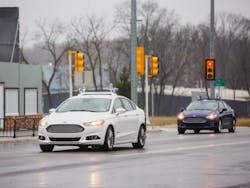Autonomous vehicles may follow the PC development pathway
One trend that’s been going on in trucking in fits and starts for a long while now is the move towards “vertical integration,” whereby truck OEMs directly manufacture most of the major components that comprise today’s commercial vehicles, such as engines, transmissions, cabs, axles, etc.
Of course many independent suppliers still remain – especially where truck tires are concerned – but even with such “outside” suppliers, exclusive “standard position” contracts often rule the day.
Yet as we begin to enter the era of autonomous vehicles (AVs) and especially self-driving trucks, this “proprietary approach,” whereby each OEM comes up with its own unique solution, may undergo some serious change – mirroring what occurred in the personal computer (PC) market several decades ago, according to Doug Davis, senior vice president and general manager of the automated driving group (ADG) at Intel Corp.
“Autonomous driving will accelerate when the industry comes together to align on common platforms and technologies. That enables developers to go quickly and in volume while still differentiating their solutions in software,” he explained in a recent opinion column.
“How do I know this? Let’s look at the PC and server industries as examples. Before 1980, the computer industry was highly proprietary, serving primarily researchers, big companies and hobbyists,” Davis noted. “This changed a few years later when IBM built the first personal computer using mostly off-the-shelf parts and an outsourced operating system.”
Those early PCs were the base for a “standardized approach” to computer design that led to faster evolution of technology and 150-times growth for the PC industry in a just two decades, he stressed.
“The data center is similar. After mainframes came microcomputers, [and they] enabled some flexibility and cost-effectiveness,” Davis pointed out.
“But it was the adaptation of PC technology that allowed data centers to evolve quickly to handle the data that came with the Internet,” he said. “[Research firm] IDC reported there were 1.8 zettabytes of data generated in 2011, and now it estimates we will generate over 40 zettabytes by 2020. Only through standardized solutions have we been able to grow the industry fast enough to keep up.”
And managing that huge volume of data will be critical to making AVs work properly – something both Davis and his Intel colleague Kathy Winter cannot emphasize enough.
“The single most important factor in autonomous driving is data – how best to process it, manage it, move it, store it, share it and learn from it,” Davis stressed. “As we move down the road toward autonomous cars, the data challenge will become much more complex and require new ways to work with data inside the vehicle, throughout the network and across the cloud.”
To ensure that the transportation industry and the system developers supporting it put “the absolute right strategy” in place to handle that massive data challenge, Davis said Intel has installed the first of several planned data centers dedicated to autonomous driving.
“These unique labs will be used for algorithm development and training, as well as for understanding the special infrastructure needs for autonomous driving data movement and storage,” he explained.
“Researchers will continually feed information from Intel’s test cars into these data centers to train neural networks and improve machine learning algorithms,” he noted.
Which brings him to artificial intelligence (AI); the linchpin on which self-driving cars will either succeed or fail.
“Mastering AI both inside the car and in the data center will be essential to the autonomous driving data challenge,” Davis said. “Here it’s important to remember that autonomous driving isn’t a game. When cars are thinking and acting without human intervention, they must be able to do so in a safe and trustworthy way.”
He added that the “artificial intelligence” needed to make all of that happen isn’t just “computer vision,” either.
“Think voice, decision-making, personalization and preferences,” Davis emphasized. “Each of those AI workloads needs a different set of algorithms and likely different kind of processing for optimum performance. If all we needed was a supercomputer to handle the autonomous driving data challenge, our work would be done.
This brings him back to AVs and to whether they will become a reality or end up as just another science-fiction pipe dream.
“There are plenty of naysayers,” Davis said. “There are plenty in the automotive industry who don’t understand how open collaboration can enable differentiation and innovation. I understand the skepticism, but from years of experience, I know that technology solves problems best when it’s organized around common platforms and predictable interfaces. Without a doubt, that’s the fastest way forward on our autonomous journey.”
Davis also doesn’t think that society as a whole can afford to continue down a proprietary path where AVs are concerned.
“The cost in time, money and human lives is too great,” he explained. “The faster we can deliver autonomous driving technology and take humans out of the driver’s seat, the faster we can save lives. It’s that simple – and that important.”
That’s one view, at least, of what’s driving the development of AVs and driverless trucks forward. We’ll see how much headway this particular philosophy gets in the trucking industry.



